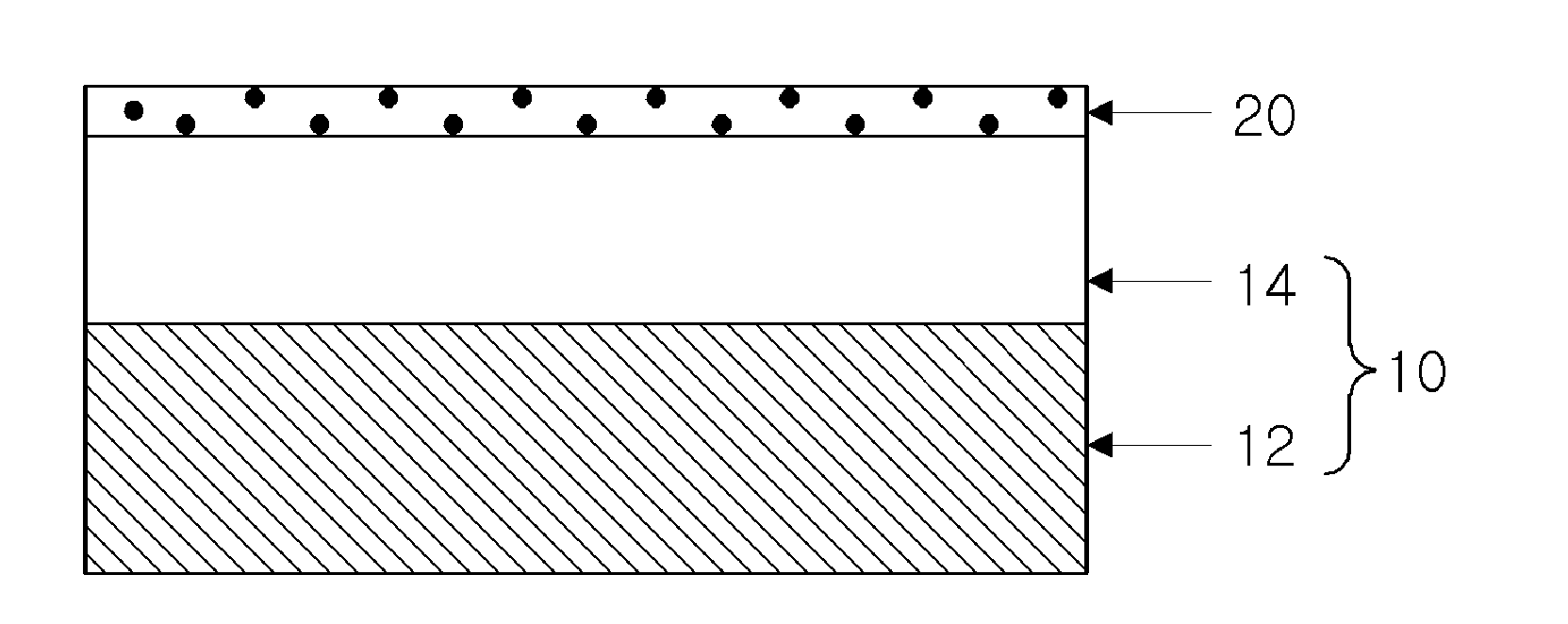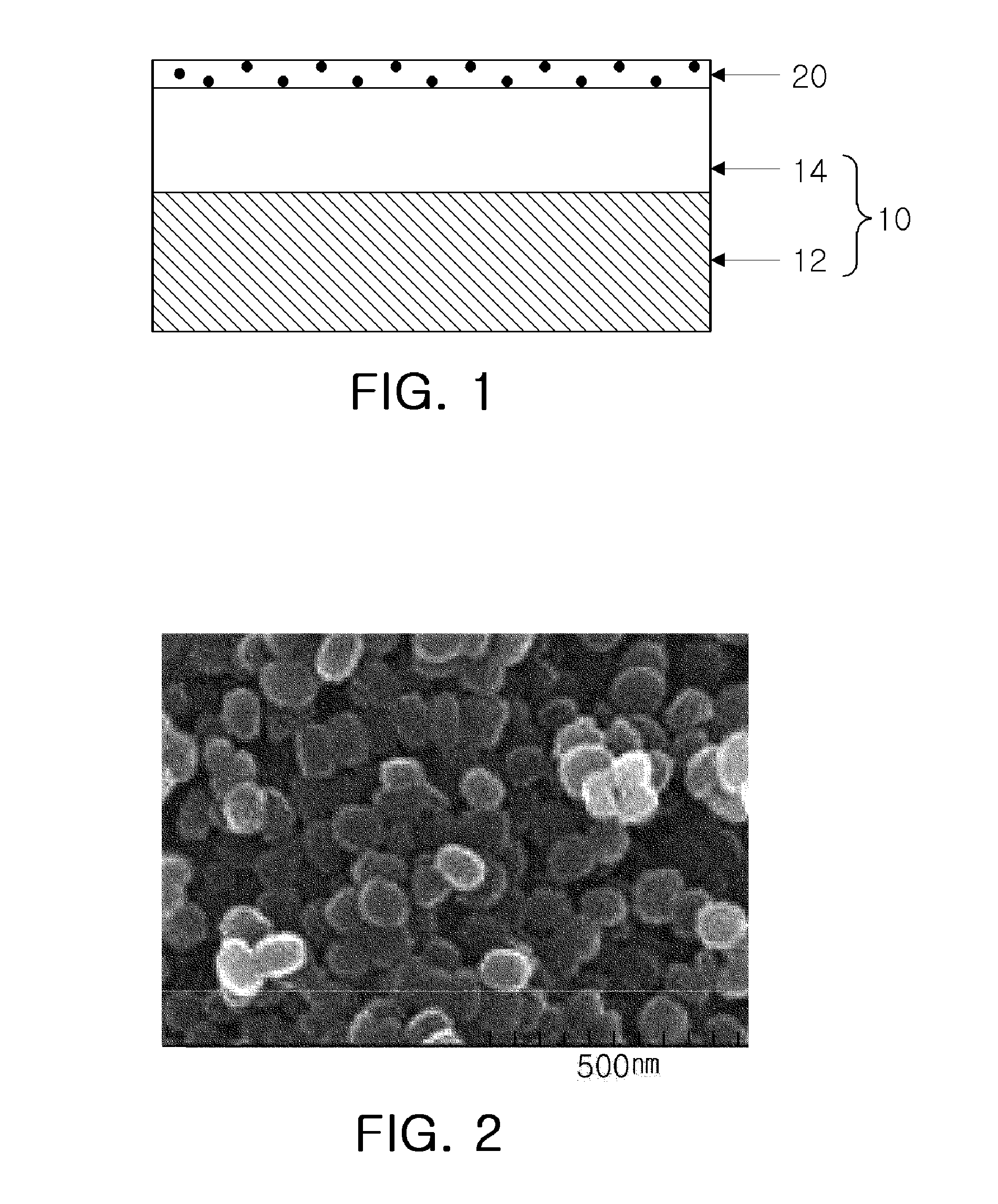High permeate flux reverse osmosis membrane including surface-treated zeolite and method of manufacturing the same
- Summary
- Abstract
- Description
- Claims
- Application Information
AI Technical Summary
Benefits of technology
Problems solved by technology
Method used
Image
Examples
fabrication example 1
Fabrication of Porous Support
[0057]18 wt % of a polysulfone solid was added to an N,N-dimethylformamide (hereinafter, referred to as “DMF”) solution and dissolved therein at a temperature of 80 to 85° C. for 12 hours or more to obtain a homogeneous liquid phase of polysulfone. The polysulfone fabricated as above was cast on a non-woven fabric formed of a polyester material and having a thickness of 95 to 100 μm, at a thickness of 45 to 50 μm and was then dipped in water. Thereby, a porous support including a polysulfone layer was obtained.
FABRICATION EXAMPLE 2
Synthesis of Zeolite (I)
[0058]0.34 g of aluminum isopropoxide was added to a mixed solution including 30.6 g of tetrapropylammonium hydroxide (hereinafter, referred to as “TPAOH”) and 11.7 g of deionized water (hereinafter, referred to as “DIW”) and was stirred therein for 1 hour. Then, after 17 g of tetraethyl orthosilicate (hereinafter, referred to as “TEOS”) was added thereto and stirred for 3 days, the stirred mixed solutio...
fabrication example 3
Synthesis of Zeolite (II)
[0060]0.34 g of aluminum isopropoxide was added to a mixed solution including 30.6 g of TPAOH and 11.7 g of DIW and was stirred therein for 1 hour. Then, after 17 g of TEOS was added thereto and stirred for 3 days, the stirred mixed solution was put into an autoclave and was subject to a hydrothermal reaction for 24 hours at 90° C. MFI type zeolite generated by cooling the autoclave at room temperature was cleaned with DIW several times using a centrifugal separator and then, the remaining non-precipitated solution was reinserted into the autoclave and was subject to a hydrothermal reaction for 7 hours at 180° C., again. MFI type zeolite generated by cooling the autoclave at room temperature was cleaned with DIW several times using the centrifugal separator and then, was dried at 70° C. The dried zeolite was fired at 550° C. for 5 hours to fabricate zeolite (II).
[0061]The zeolite (II) fabricated by the method had an average particle diameter of 150 nm, a mi...
fabrication example 4
Synthesis of Zeolite (III)
[0062]0.34 g of aluminum isopropoxide was added to a mixed solution including 30.6 g of TPAOH and 11.7 g of DIW and was stirred therein for 1 hour. Then, after 17 g of TEOS was added thereto and stirred for 3 days, the stirred mixed solution was put into an autoclave and was subject to a hydrothermal reaction for 24 hours at 90° C. MFI type zeolite generated by cooling the autoclave at room temperature was cleaned with DIW several times using a centrifugal separator and then, the remaining non-precipitated solution was reinserted into the autoclave and was subject to a hydrothermal reaction for 24 hours at 120° C., again. MFI type zeolite generated by cooling the autoclave at room temperature was cleaned with DIW several times using the centrifugal separator and then, was dried at 70° C. The dried zeolite was fired at 550° C. for 5 hours to fabricate zeolite (III).
[0063]The zeolite (III) fabricated by the method had an average particle diameter of 80 nm, a ...
PUM
| Property | Measurement | Unit |
|---|---|---|
| Particle diameter | aaaaa | aaaaa |
| Particle diameter | aaaaa | aaaaa |
Abstract
Description
Claims
Application Information
 Login to View More
Login to View More - R&D
- Intellectual Property
- Life Sciences
- Materials
- Tech Scout
- Unparalleled Data Quality
- Higher Quality Content
- 60% Fewer Hallucinations
Browse by: Latest US Patents, China's latest patents, Technical Efficacy Thesaurus, Application Domain, Technology Topic, Popular Technical Reports.
© 2025 PatSnap. All rights reserved.Legal|Privacy policy|Modern Slavery Act Transparency Statement|Sitemap|About US| Contact US: help@patsnap.com



